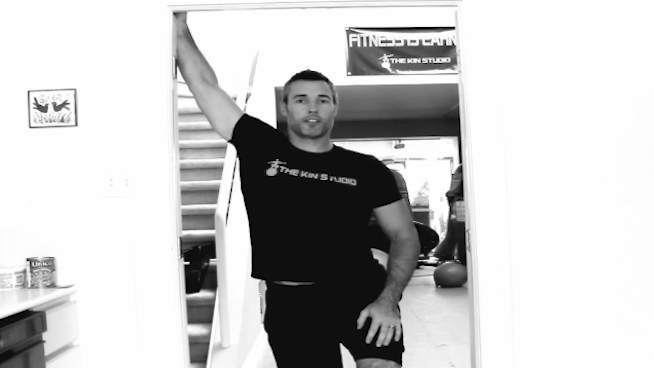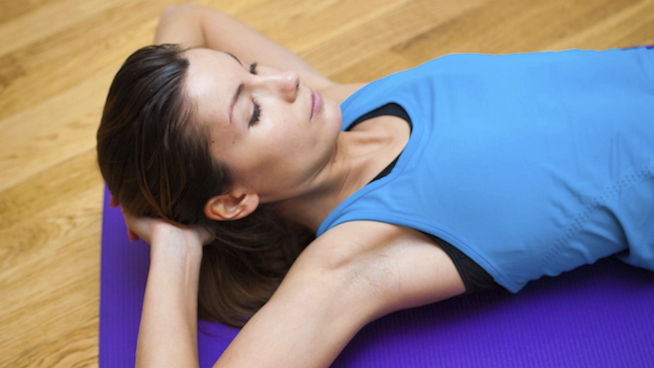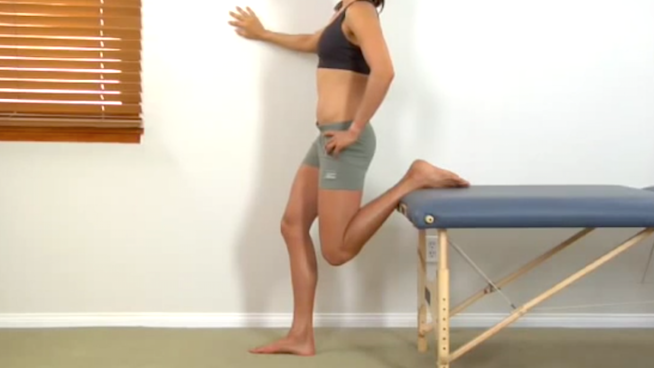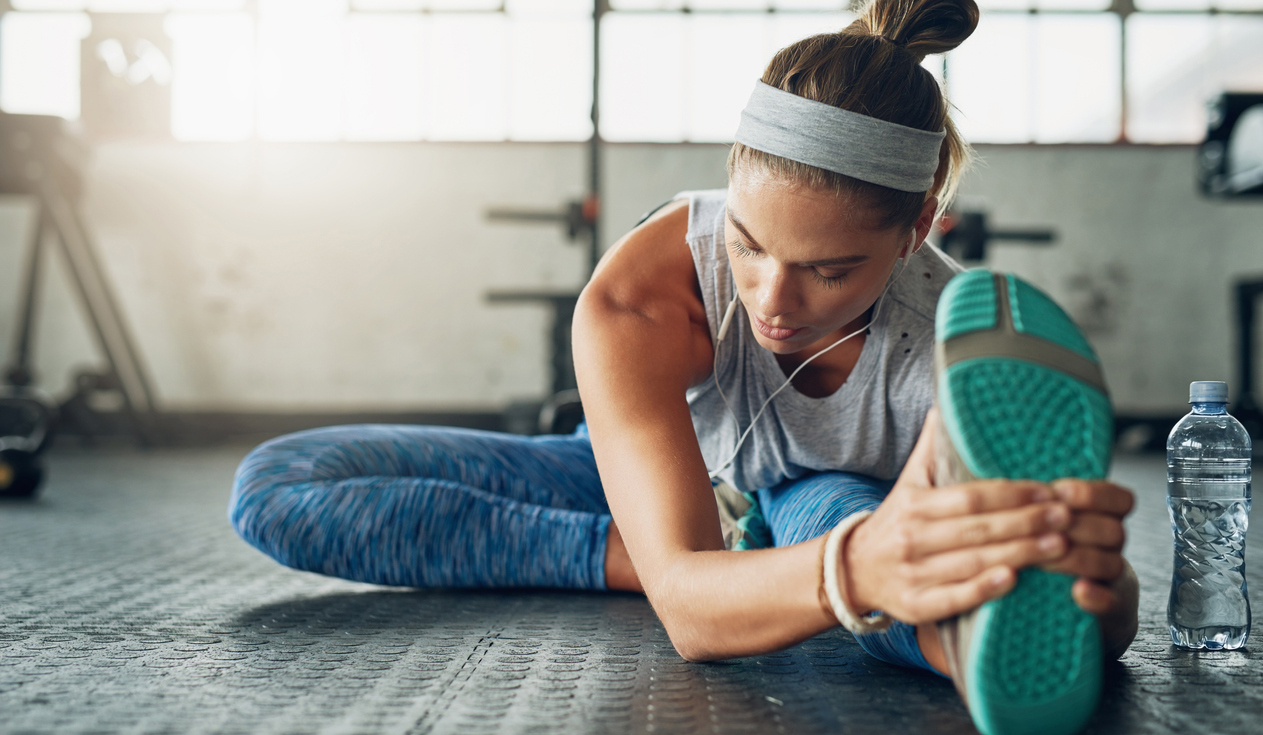3 Super Simple Stretches That Alleviate the Pain of Prolonged Desk-Sitting
![]()
Sitting at a desk for hours on end is certainly no fun. But it’s especially awful when that prolonged period of hunched focus wreaks havoc on your body. Whether you’re a desk jockey or just a diligent student, you know the effects that prolonged periods of seated work in front of a computer or textbook can have. Your neck gets stiff, your back hurts and your legs get tight. And these negative effects usually linger long after you’ve finished your work, causing your movement and quality of life to suffer.
Stretching is one of the best weapons for relieving these nagging pains. Performing just a few simple-yet-effective desk stretches can alleviate pain, increase quality of movement and lead to a happier overall life. With the help of Alex Allan, a Registered Kinesiologist and the owner of The Kin Studio in Toronto, we compiled three simple stretches to help you combat seated-related stiffness.
1. Problem Area: Chest
Sitting at a desk for an extended period of time forces the body forward. Think about the position you’re in while at the computer—your neck is likely craned in front of your chest, your shoulders are likely rolled forward and up towards your head, your hands are out in front of you, and you’re probably bent forward at the pelvis with a rounded back. Over time, this hunched position tightens the muscles on the front of your body, such as the hip flexors and the chest, and lengthens the muscles on the back of your body, such as the upper back. The result can be stiffness in a variety of areas, in addition to a poor, slumping posture even when you’re standing up. The best fix is to sit with better posture, that it can be hard to keep that in mind when you’re focused.
To address the tightening of muscles on the front of your body and the lengthening of muscles on the back, the anterior (front) muscles need to be opened up, and the back (posterior) muscles need to be activated. “You’ve got to open up the tight anterior structures and prep for posterior activation of the muscles that’ve been lengthened all day,” Allan says.
Solution Stretch: Doorframe Pec Stretch

- Find a doorframe.
- Get into a kneeling position inside the door frame, leaving about a foot of space between your body and the frame.
- Raise whatever arm is opposite of your front knee above your head and grab the door frame, keeping your back straight and your eyes forward.
- Gently rotate your chest away from the elevated arm and push your upper-body forward.
- Hold for 30-45 seconds.
2. Problem Area: Neck and Upper Back
The neck and the upper back are two of the most common areas to experience work-related pain and stiffness. You’ll likely feel these spots tighten up as you work for an extended period of time, leading you to roll your neck and shrug your shoulders in an attempt to loosen them up. These two spots can be difficult to stretch successfully, but this simple move from Allan should help to alleviate both neck and upper back stiffness.
Solution Stretch: Supine Neck Stretch

- Lie on your back.
- Interlace your fingers behind the base of your skull, lifting your head slightly.
- Gently squeeze and hold your shoulder blades back and down, as if you’re dropping your shoulder blades into your back pockets.
- Push your head against your hands, providing gentle pressure. Keep your chin in a neutral position.
- Try to keep your elbows on the ground without letting your shoulders rise up.
- Hold for 30-45 seconds.
3. Problem Area: Lower Back and Hip Flexors
The lower back and the hips—specifically the hip flexors—are two more common areas that experience problems when you’re sitting for a prolonged period of time. If you’re someone who likes to hit the gym after working or studying, the stiffness in these areas can make your workout a real pain (no pun intended).
Tight hip flexors can lead to a posture problem known as anterior pelvic tilt, which essentially means you’re walking around with your stomach and shoulders well in front of your hips and lower body. It’s not a flattering look. If you experience either lower back or hip flexor tightness from prolonged periods of working or studying, give this move from Allan a shot. “This one releases tension in hips and lower back more than anything I’ve ever seen, especially for seated workers who are in hip flexion for hours a day,” Allan says.
Solution Stretch: Standing Rectus Femoris Stretch

Photo: YouTube, Optimum Care Provider
- Find a step, bench or chair that’s roughly a foot or two high.
- Place the top of your back foot onto the surface of said object.
- Your front foot should be directly beneath your hips.
- Lean back slightly by pushing your pelvis forward.
- Contract your core and your glutes.
- Slowly lower yourself by bending your front knee until you feel a stretch in the front of your back leg.
- Hold for 30-45 seconds.
RECOMMENDED FOR YOU
MOST POPULAR
3 Super Simple Stretches That Alleviate the Pain of Prolonged Desk-Sitting
![]()
Sitting at a desk for hours on end is certainly no fun. But it’s especially awful when that prolonged period of hunched focus wreaks havoc on your body. Whether you’re a desk jockey or just a diligent student, you know the effects that prolonged periods of seated work in front of a computer or textbook can have. Your neck gets stiff, your back hurts and your legs get tight. And these negative effects usually linger long after you’ve finished your work, causing your movement and quality of life to suffer.
Stretching is one of the best weapons for relieving these nagging pains. Performing just a few simple-yet-effective desk stretches can alleviate pain, increase quality of movement and lead to a happier overall life. With the help of Alex Allan, a Registered Kinesiologist and the owner of The Kin Studio in Toronto, we compiled three simple stretches to help you combat seated-related stiffness.
1. Problem Area: Chest
Sitting at a desk for an extended period of time forces the body forward. Think about the position you’re in while at the computer—your neck is likely craned in front of your chest, your shoulders are likely rolled forward and up towards your head, your hands are out in front of you, and you’re probably bent forward at the pelvis with a rounded back. Over time, this hunched position tightens the muscles on the front of your body, such as the hip flexors and the chest, and lengthens the muscles on the back of your body, such as the upper back. The result can be stiffness in a variety of areas, in addition to a poor, slumping posture even when you’re standing up. The best fix is to sit with better posture, that it can be hard to keep that in mind when you’re focused.
To address the tightening of muscles on the front of your body and the lengthening of muscles on the back, the anterior (front) muscles need to be opened up, and the back (posterior) muscles need to be activated. “You’ve got to open up the tight anterior structures and prep for posterior activation of the muscles that’ve been lengthened all day,” Allan says.
Solution Stretch: Doorframe Pec Stretch

- Find a doorframe.
- Get into a kneeling position inside the door frame, leaving about a foot of space between your body and the frame.
- Raise whatever arm is opposite of your front knee above your head and grab the door frame, keeping your back straight and your eyes forward.
- Gently rotate your chest away from the elevated arm and push your upper-body forward.
- Hold for 30-45 seconds.
2. Problem Area: Neck and Upper Back
The neck and the upper back are two of the most common areas to experience work-related pain and stiffness. You’ll likely feel these spots tighten up as you work for an extended period of time, leading you to roll your neck and shrug your shoulders in an attempt to loosen them up. These two spots can be difficult to stretch successfully, but this simple move from Allan should help to alleviate both neck and upper back stiffness.
Solution Stretch: Supine Neck Stretch

- Lie on your back.
- Interlace your fingers behind the base of your skull, lifting your head slightly.
- Gently squeeze and hold your shoulder blades back and down, as if you’re dropping your shoulder blades into your back pockets.
- Push your head against your hands, providing gentle pressure. Keep your chin in a neutral position.
- Try to keep your elbows on the ground without letting your shoulders rise up.
- Hold for 30-45 seconds.
3. Problem Area: Lower Back and Hip Flexors
The lower back and the hips—specifically the hip flexors—are two more common areas that experience problems when you’re sitting for a prolonged period of time. If you’re someone who likes to hit the gym after working or studying, the stiffness in these areas can make your workout a real pain (no pun intended).
Tight hip flexors can lead to a posture problem known as anterior pelvic tilt, which essentially means you’re walking around with your stomach and shoulders well in front of your hips and lower body. It’s not a flattering look. If you experience either lower back or hip flexor tightness from prolonged periods of working or studying, give this move from Allan a shot. “This one releases tension in hips and lower back more than anything I’ve ever seen, especially for seated workers who are in hip flexion for hours a day,” Allan says.
Solution Stretch: Standing Rectus Femoris Stretch

Photo: YouTube, Optimum Care Provider
- Find a step, bench or chair that’s roughly a foot or two high.
- Place the top of your back foot onto the surface of said object.
- Your front foot should be directly beneath your hips.
- Lean back slightly by pushing your pelvis forward.
- Contract your core and your glutes.
- Slowly lower yourself by bending your front knee until you feel a stretch in the front of your back leg.
- Hold for 30-45 seconds.










